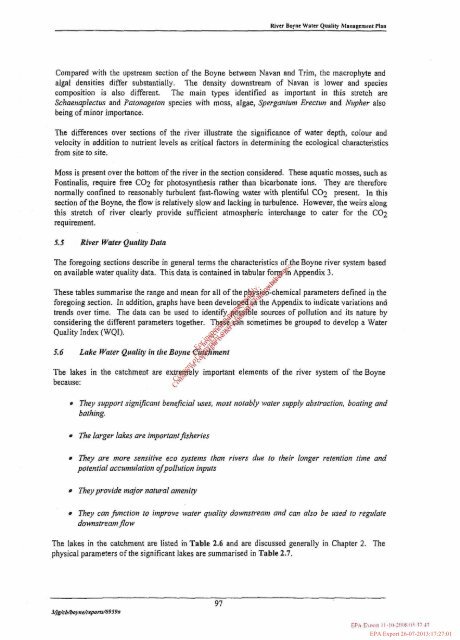River Boyne Water Quality Management Plan - EPA
River Boyne Water Quality Management Plan - EPA
River Boyne Water Quality Management Plan - EPA
You also want an ePaper? Increase the reach of your titles
YUMPU automatically turns print PDFs into web optimized ePapers that Google loves.
<strong>River</strong> Boynr <strong>Water</strong> Qualiry hlnnagrmrnl <strong>Plan</strong>Compared with the upstream section of the <strong>Boyne</strong> between Navan and Trim, the macrophyte andalgal densities differ substantially. The density downstream of Navan is lower and speciescomposition is also different. The main types identified as important in this stretch areSchaenaplectus and Patonageton species with moss, algae, Sperganium Erectun and N~pher alsobeing of minor importance.The differences over sections of the river illustrate the significance of water depth, colour andvelocity in addition to nutrient levels as critical factors in determining the ecological characteristicsfrom site to site.Moss is present over the bottom of the river in the section considered. These aquatic mosses, such asFontinalis, require free C02 for photosynthesis rather than bicarbonate ions. They are thereforenormally confined to reasonably turbulent fast-flowing water with plentiful C02 present. In thissection of the <strong>Boyne</strong>, the flow is relatively slow and lacking in turbulence. However, the weirs alongthis stretch of river clearly provide sufficient atmospheric interchange to cater for the C02requirement.5.5 <strong>River</strong> <strong>Water</strong> Qrmlity DnfaThe foregoing sections describe in general terms the characteristics of the <strong>Boyne</strong> river system basedon available water quality data. This data is contained in tabular fowqn Appendix 3.These tables summarise the range and mean for all of the p&si&-chemical parameters defined in the-. .'9foregoing section. In addition, graphs have been deve~o~e&~& the Appendix to indicate variations and.\trends over time. The data can be used to identify @*&le sources of pollution and its nature byconsidering the different parameters together. he$'@% sbmetimes be grouped to develop a <strong>Water</strong>.c. >@pnaerttThe lakes in the catchment are extre&lybecause: c$Le\$,s"important element5 of the river system of the <strong>Boyne</strong>They support signiJcanr beneficial rues, most notably water szpply abstrocfioti, boating andbathing.The larger lakes are importantfisheriesThey are niore sensitive eco systems than rivers dzrr to their longer retention time andpotential accumulation ojpollution inputsThey provide major natural amenityFor inspection purposes only.Consent of copyright owner required for any other use.They can function to improve water qiiality downstream and can also be used to regrrlatedownstreaniflowThe lakes in the catchment are listed in Table 2.6 and are discussed generally in Chapter 2. Thephysical parameters of the significant lakes are summarised in Table 2.7.<strong>EPA</strong> Export 26-07-2013:17:27:01
















